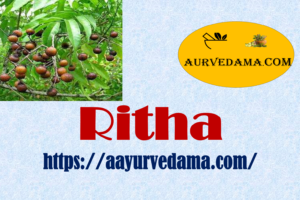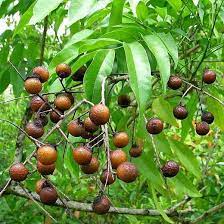Ritha
Ritha is a tree belonging to the family Sapindaceae and is found in evergreen forests. This tree is native to South India. Its height usually ranges from 20 to 30 feet. Its flowers are petalled and white in color. Fruits appear yellowish green when ripe. Its fruit produces black lumps.

Ritha is a deciduous tree belonging to Sapindaceae family and its scientific name is Sapindus trifoliatus. Lychee and Bacillus are also in the Sapindaceae family. Ritha is native to India and is cultivated in the states of West Bengal, Bihar, Madhya Pradesh and Uttar Pradesh. Apart from this, it is also planted for decoration. In the Sahyadri area, his Sa. The genus laurifolius is found. But S. trifoliatus and s. Scientists believe that laurifolius are the names of the same plant. Ritchi Sa in India. Makerosi is another variety found. It is native to China and is cultivated in North India.
Ritha (Sapindus trifoliatus) : (1) Plant; (2) Florora; (3) Fruit puree, (4) Dried dry fruits

Tree
Tree
Ritha is a medium-sized tree, but under favorable conditions, Su. 20 m. Can grow tall. The bark is gray and shiny with rough and falling scales. The leaves are compound, alternate and large. Each dal is spear-like, oval or rectangular in shape. The flowers are small, regular and white and come in panicles. Corolla 3 mm. It is long and hairy. Nidalpunj is composed of five parts and is joined at the bottom. Dalpunj has five petals and the petals are free. There are eight spare stamens in pumanga. The jayang is vertical and consists of three jointed andaps. Flowers bloom in winter. The inflorescence is somewhat smaller, hairy and sparse than that of mango. Its color is greenish white and it has numerous and small flowers. Fruits are produced in summer. They are round and hollow but distinctly triangular. The seeds are black, twice the size of a pea, round and hard.
Ritha fruits
Its Fruits are mainly used to remove feces. It contains compounds of the saponin class. These compounds are water-soluble glycosides. The saponins in the fruits form a foam when they are soaked in water. So they are used like soap. Rithas are used for washing woolen, silk and delicate and talam cotton clothes. Nowadays they are also used in washing powder. Ritta fruits are used to clean and polish gold jewelry and make soap, shampoo and toothpaste as well as insecticides. Roots and fruits are used as medicines in Ayurvedic and Unani healing systems. Asthma, hemoptysis, arthritis, spider bite etc. Fruits are considered beneficial for disorders. The heartwood is hard, heavy and yellowish in color. They are used for construction and making bullock carts. Seedlings can be produced from seeds. Ritha is a useful tree for roadside shade, ornamental in parks and forestry.
Ritha benefits
1) In case of inflammation of the body, rubbing the foam on the body feels relief.
2) Stomach ache in small children due to stomach worms. In such a case, if the shell of pav gram rice is chewed through jaggery, the worms will fall.
3) If the phlegm is sticky, keep it empty in the mouth and swallow little by little, the phlegm becomes thinner and falls off.
4) If a person falls into a fit, the best remedy is to drop boiled water in the nose.
5) If any kind of poison enters the stomach, empty water should be given to drink. This induces vomiting and expels the poison.
6) Rithes are used when making spicy shikekai. It acts as a natural conditioner.
7) If gold or silver ornaments are soaked in that water after soaking, the adhering dirt will be removed and the ornament will be clean and shiny.
8) If you soak it in water and crush it well and rub the water on the body, it reduces the problem of bile rising on the body.
9) In case of sudden urge to urinate, khakare seeds and ritha seeds should be soaked in water and applied around the abdomen and given a shake. This clears the urine.
Source : Wikipediya
Faq –
1 In case of inflammation of the body, rubbing the foam on the body feels relief. Tell me right or wrong ?
2 Ritha plant belongs to which genus ?
3 How is Ritha plant useful in Kapha ?